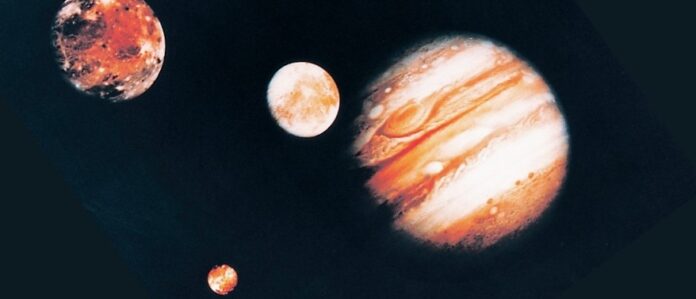Background: The Phenomena
Behold Jupiter’s magnificent magnetic field and atmosphere, which produce awe-inspiring aurorae. As if that’s not enough, the Galilean Moons – Io, Europa, Ganymede, and Callisto – Jupiter’s largest moons, also generate aurorae. Sadly, these are elusive to detect as the light signatures are washed out by sunlight reflected from the surfaces of the moons.
Observations: Discovering the Enthralling Reds
However, a team of astronomers overcame this obstacle by observing the moons as they passed into Jupiter’s shadow. What they discovered is that the moons have oxygen-aurorae in their atmospheres that are deep red, dazzling, and nearly 15 times brighter than the aurorae we witness here on Earth. The data combined from the Keck Observatory’s High-Resolution Echelle Spectrometer and high-resolution spectra from the Large Binocular Telescope and the Apache Point Observatory helped the team make these discoveries.
Composition of Atmospheres: Oxygen Content
The observations also revealed that the Galilean Moons’ atmospheres contain oxygen gas, indicating that all four moons have the same oxygen aurorae. The aurorae are comparable to the Aurora Borealis and Australis observed on Earth. The oxygen content in the atmosphere of Europa, Ganymede, and Callisto is due to photolysis. The process involves water ice sublimating and breaking down into hydrogen gas and oxygen as a result of solar radiation. In Io’s case, the sulfur dioxide interacts with solar radiation to form sulfur monoxide and elemental oxygen, which causes the oxygen in its atmosphere.
Response to Temperature Changes: Understanding Io’s Atmospheric Chemistry
In addition to discovering the Galilean Moons’ oxygen aurorae, the observations showed how the moons’ atmospheres rapidly responded to temperature changes as they passed into Jupiter’s shadow from exposure to sunlight. This new insight is especially helpful in understanding Io’s atmospheric chemistry.
Implications for Future Missions: A Sight to Behold
Future missions such as NASA’s Europa Clipper and ESA’s JUpiter ICy moon Explorer (JUICE) are expected to conduct multiple flybys of these moons, collect data on their atmosphere and surface compositions, and attempt to identify indications of possible life within their interiors. The red aurorae on these moons will undoubtedly be a thrilling sight to witness up close.
Variations in Aurorae Brightness: Jupiter’s Tilted Magnetic Field
The observations also revealed that Jupiter’s tilted magnetic field causes the aurorae to differ in brightness as the gas giant rotates. The tilt of Jupiter’s magnetic field, which is approximately 10 degrees from Jupiter’s axis of rotation compared to Earth’s 11-degree tilt, means that the moons will experience a more significant interaction at certain points in their orbit.
Minimal Evidence of Water Vapor: Mystery Persists
The new measurements also revealed minimal evidence of water vapor, which was previously thought to be a component in the atmospheres of Europa, Ganymede, and Callisto. All three moons are thought to have interior oceans beneath their icy surfaces, and there is even tentative evidence that the water vapor in Europa’s atmosphere may result from plume activity. These plumes are thought to be connected to the moon’s interior ocean or liquid reservoirs within its icy shell.
Infrared Glow: Oxygen’s Red Light Show
Moreover, the observations showed that astronomers observed an infrared glow in the atmospheres of these moons for the first time. Due to their much thinner atmospheres, the oxygen glows in deep red and, for Europa and Ganymede, in infrared wavelengths, which is not visible to the human eye.
Conclusion: A Field of Research Full of Excitement
These recent observations have added more excitement to an already thrilling field of research. The observations have provided new insights into the composition of the Galilean Moons’ atmospheres, their response to temperature changes, and variations in aurorae brightness. Future missions such as NASA’s Europa Clipper and ESA’s JUpiter ICy moon Explorer (JUICE) will provide even more valuable data that may help us better understand these fascinating moons and potentially uncover signs of life in their interiors. The bright red aurorae on these moons, along with the infrared glow and the mystery of water vapor, all make for an enthralling light show that is sure to captivate us for years to come.














